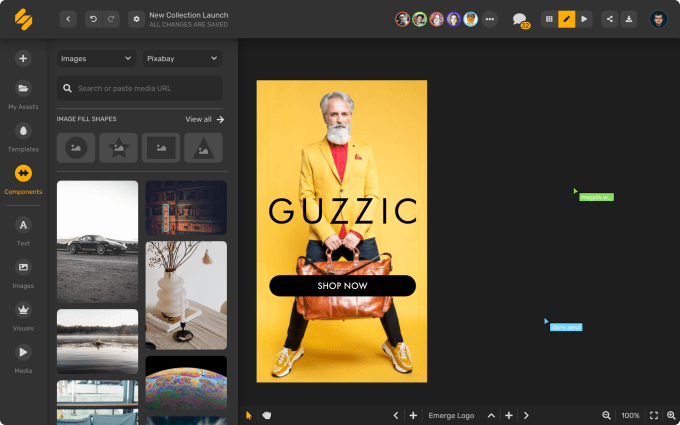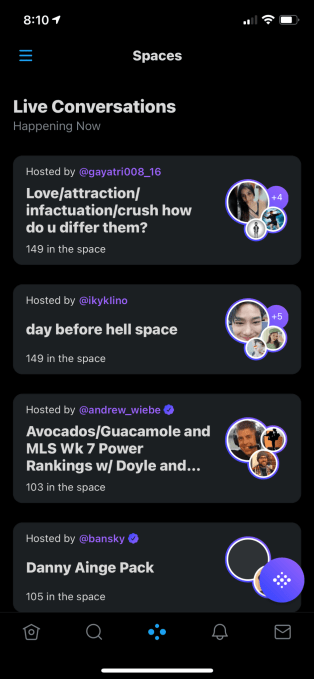Disrupt 2020 was an absolute banger of a conference, but we’re not ones to rest on our laurels. We have an incredible Disrupt in store for you this September 21-23, with an amazing line up of speakers across the hottest of topics, like crypto, health/biotech, SPACs, the creator economy, and the usual spread of startup how-to content and fundraising strategies and tactics.
And we’re ahead of schedule, which means we’re ready to share with you some of the speakers that will be gracing the Extra Crunch stage. As former Disrupt attendees know, the conference features two different stages: the Disrupt stage and the Extra Crunch stage.
The Extra Crunch stage is all about giving founders and operators as much strategic insight as possible, across a wide variety of startup core competencies, such as fundraising, product iteration, tech stack development, growth marketing and more.
As with past years, CrunchMatch (our system for matching investors with entrepreneurs and connecting all attendees) will be running throughout the whole show.
Today, we’d like to share with you a first look at the Disrupt 2021 agenda for the Extra Crunch Stage. More speakers will be added to this agenda, but we couldn’t resist giving you a peek under the hood.
Take a look and then grab your pass to join in on the action for under $99!
Tuesday, September 21
How to Raise Your First Dollars with Luciana Lixandru (Sequoia), Rebecca Lynn (Canvas Ventures)
Deciding how to go about getting your initial funding is always a tricky subject, as the wrong move could adversely impact your young company. In this session we’ll hear from experts who’ve shepherded multiple companies from the earliest to the latest fundraises.
How to Cultivate a Community for your Company that Actually Lasts with Alex Angel (Commsor), Katelin Holloway (776 Ventures), and Lolita Taub (The Community Fund)
There’s no doubt about it: the word of the year in startupland is “community.” In this panel, Community Fund’s Lolita Taub, Commsor’s Alex Angel, and 776 Ventures’ Katelin Holloway will extract buzz from reality and help founders understand the growing importance of chief community officers in startup culture, and ultimately financial success, today.
The Subtle Challenges of Assessing Product-Market Fit with Heather Hartnett (Human Ventures), David Thacker (Greylock), and Victoria Treyger (Felicis Ventures)
Product-market fit is the holy grail for founders, and the key to unlocking the next phase of a startup’s growth. Behind “product” and “market” though, there are dozens of considerations, from types of users and product offerings to marketing and pricing that determine just how strong a fit a startup has found. Join early-stage investors David Thacker of Greylock, Heather Hartnett of Human Ventures and Victoria Treyger of Felicis as they discuss the subtler challenges in finding and assessing fit.
Sponsored: Powering the Small Business Economy with Cloud Technology by Steve Vamos, CEO of Xero
Small business is a critical engine of job creation, economic growth, innovation and a driver in our efforts to recover from a global pandemic. Fifteen years ago a start-up company from New Zealand called Xero was founded with the purpose of making life better for people in small business and their advisors. Xero achieved this by shifting accounting practices to the cloud and providing an open set of APIs which has enabled more than 1000 application partners to build affordable tech solutions connected to the Xero platform. Steve Vamos, CEO will discuss how Xero is revolutionizing the way small businesses do business by using cloud and its platform to connect real-time data, with bespoke business solutions that help small business owners be more successful. Steve will speak to a number of key initiatives that will change the game for startups and entrepreneurs who want to innovate and collaborate on the Xero platform, and he will explain how Xero’s vision extends beyond just technology to galvanizing a global community of support and purpose to help small businesses everywhere.
How to Accelerate Everything with Nik Sharma (Sharma Brands) and speakers to be announced
In the past year, growth marketing exploded as companies doubled down on what’s worked in the past and found new runway inside an increasingly competitive landscape. We brought together some of the best growth marketing minds across verticals to tell you how they conquered growth in 2021.
How to Ditch Traditional Fundraising with Arun Mathew (Accel), Nicholas Tommarello (Wefunder) and Michele Romanow (Clearco)
In 2021, venture capital has never been more plentiful, but some founders still can’t break into networks or have found that traditional fundraising isn’t the best route for their business. Fortunately, alternative fundraising techniques are gathering steam as founders find paths to raise cash that diverge from the startup success stories of the past.
The Pros and Cons (but mostly pros) of a Distributed Workforce with Wendy Nice Barnes (GitLab) and speakers to be announced
Coronavirus has changed so much, but perhaps nothing about our everyday lives has changed quite as much as the way we work. Corporations and small businesses the world over have moved to remote work, and as per usual in a time of change, startups have the advantage. Hear from founders who have cultivated fast-moving, highly productive (yet still culture-conscious) distributed workforces and how they’ve managed to do so.
Wednesday, September 22
The Path for Underrepresented Entrepreneurs with Hana Mohan (MagicBell), Leslie Feinzaig (Female Founders Alliance), and Stephen Bailey (ExecOnline)
Being a founder comes with a wide array of challenges, but underrepresented founders unfortunately face an extra layer of bias, both conscious and unconscious. At Disrupt, we’ll sit down with founders who will share their journey through fundraising and scaling, as well as advocates who can offer tactical insights and advice.
How to Sign Your First Three B2B Customers with Kate Taylor (Notion), Abi Williams (Udemy)
The secret to revenue growth is great sales, but the definition of “great” and “sales” has changed dramatically post-COVID. Virtual meetings, simple onboarding, product-led growth, and more have upended the traditional approach to sales for enterprise companies, requiring new tactics for founders to get the kind of skyrocketing growth they desire and lock in those first customers. Join Abi Williams of Udemy and Kate Taylor of Notion as we discuss the best practices for handling sales in a re-energized 2021 economy.
So, You Want to Go Public. What’s Next? with Hope Cochran (Madrona Venture Group) and Deena Shakir (Lux Capital)
The path to your startup’s exit has grown increasingly complex in the last year. Acquisition? SPAC? Traditional IPO. Hear from seasoned tech experts about how to think about your company’s path to going public and weigh the pros and cons of the various routes.
Why You Probably Have Been Screwing Up Your Hiring Process with Jaime Bott (Sequoia Capital), Tawni Cranz (SignalFire), Doris Tong (EQ Talent Group)
Distributed workforces have rapidly become the new normal – but chances are that your hiring processes haven’t been re-invented at the same clip. In this panel, a host of experts including EQ Talent Group’s Doris Tong, SignalFire’s Tawni Cranz, and Sequoia’s Jaime Bott – will discuss how to hire with culture and competence at the core of each decision. And, more importantly, what within your process needs to be scrapped and rewritten for the post-pandemic world.
Where to Cut and Where to Spend in First-Check Fundraising with Nisha Dua (BBG Ventures), Richard Kerby (Equal Ventures), and Henri Pierre-Jacques (Harlem Capital)
Every time a founder raises financing, they usually have one goal: growth. But what does that actually mean? And how do you begin divvying up your new capital between the various goals your startup is barreling toward? In this panel, which includes Harlem Capital’s Henri Pierre-Jacques, Equal Ventures’ Richard Kerby, and BBG Ventures’ Nisha Dua, you will learn about how to spend your investment the best way, balancing runway with classic startup rigor.
Crafting a Pitch Deck that Can’t Be Ignored with Mercedes Bent (Lightspeed Ventures), Mar Hershenson (Pear VC), and Saba Karim (Techstars)
Investors may be chasing after the hottest deals, but for founders selling their startup’s vision, it’s never been more important to communicate it in the clearest way possible. Our panelists of pitch deck experts are digging into what’s essential, what’s unnecessary and what could just make all the difference in your next deck.
Thursday, September 23
How Do You Select the Right Tech Stack with Jill Wetzler (Pilot) and speakers to be announced
From day zero, startups have to make dozens of trade-offs when it comes to the infinite variety of tech stacks available to today’s engineers. Choose the wrong combination or direction, and a startup could be left with years of refactoring to fix the legacy damage. What are the best practices for assessing potential stacks, and how can you minimize the risk of a painful mistake? Top technologists will discuss strategies for improving engineering right from the beginning and at every stage of a startup’s journey.
How to Build Brand Buzz and Generate Influence in the Creator Economy with Rachel Drori (Daily Harvest) and Julia Munslow (Yahoo News)
Brands are the lifeblood of startups. The name, the design, the feel, and the emotional connection between customers and company can determine the entire trajectory of a business. It’s a well-trodden field that’s been upended in recent years thanks to the skyrocketing growth of the influencer and creator economies. What does it mean to build a brand in today’s competitive marketplace and how can you assess success? Julia Munslow of Yahoo News and Rachel Drori of Daily Harvest will discuss how they built and reshaped brands for 2021, and what tools founders should consider today in designing a compelling brand.
How to Use Customer Feedback and Data Analysis to Iterate Your Product with Eleanor Morgan (InVision) and Jean-Denis Greze (Plaid)
Everyone has an opinion on product changes. Customers complain, NPS scores are calculated, and internal leaders have their own vision on what comes next. Then there are all the people who are silent — including future customers who may not even know a startup exists yet. How do you find signal from all the noise and build a compelling product roadmap that properly calibrates every tradeoff? Jean-Denis Greze of Plaid and Eleanor Morgan of InVision offer their perspectives as product leaders on how to keep a bold perspective in product while getting the details right.
Pitch Deck Teardown with Maren Bannon (January Ventures), Melody Koh (NextView Ventures), and Benjamin Ling (Bling Capital)
An articulate, alluring pitch presentation is a big part of successfully fundraising, and yet it’s relatively uncommon for founders to get candid feedback on how they communicated the problem, their solution, and their path to success. During the Pitch Deck Teardown, VCs will offer their live feedback on decks submitted by audience members.
How DAOs Could Shake Up VC with David Pakman (Venrock) and speakers to be announced
Investment in blockchain startups and tokens exploded in 2021, and some investors are blowing up the idea of a venture capital firm as they look to back more projects in the crypto world. DAOs, or Decentralized Autonomous Organizations, are starting to pop up more and more, turning traditional VC on its head by building investment organizations on the blockchain.
Pass prices for Disrupt are just $99 for a limited time – so if you want to get in on this action, get yours today and save up to $300.











